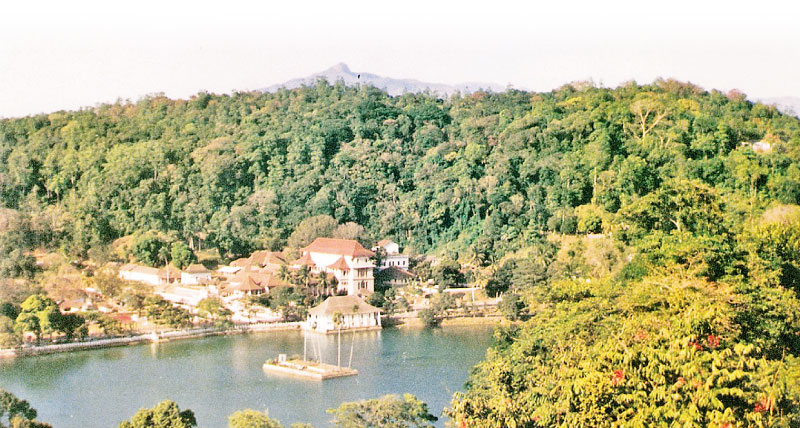The lush forest cover behind Sri Dalada Maligawa in Kandy has a long history dating back to many centuries. It was declared Thahansikele or forbidden forest by the Sinhala kings who ascended the throne when Kandy became the capital city.
It was a royal forest reserve where no one was allowed to venture, located close to Sri Dalada Maligawa and the Royal Palace. In this verdant jungle where among trees, creepers, lichen, mosses, ferns, grasses, fungi and bacteria are found in abundance. The forest remained impenetrable for over many centuries where wild boar, monkey, hare, squirrel, scaly, anteater, porcupine, and reptiles, monitor lizard, tortoise and varieties of birds, worms and insects live in perfect harmony with nature.
Heavy foliage
The pond in the heart of the jungle was the place where queens in the past bathed and used as their garden. At times of war, kings always used the forest cover for their defense against attacks and very often they escaped through the heavy foliage to a safer place in the hills. In the past elephant, elk and leopard roamed freely among tall giant trees and hanging creepers. The leaves that fell from trees and creepers on the ground keep the surface moist after intermittent showers. Throughout history the atmosphere around Udawttakale evoked a certain feeling of mysterious nature. The noise of cicadas makes the mystery deeper creating reverence and awe.
The Asgiri upatha the historical record describes how Udawattakele become a forest reserve when the ancient village, Senkadagala was chosen as one of the early settlements in the country. According to this historical record the first settlement was founded during the rule of king Gajabahu of Anuradhapura (114-136AC).There is reference to the Maha Thera Palabathgala Wanarathana of the lineage of Dimbulagala Dipankara Thero who brought four other bhikshus to Senkadagala during to the rule of King Panditha Parakramabahu of Kurunegala.
However, King Wickremabahu of Gampola is populary believed to be the founder of the city of Senkadagala who built his palace on a site carved out of Udawattekele. It is for this reason that the name Udawasalawatta was called, and it is now called Udawattakele.
Unbelievably impregnable
Udawattakele was the watershed for streams that fed the Natha Devala paddy fields, which was later made in to the present Kandy Lake. There where streams of water that flow down event to this day from Udawattakele. ‘This forest possesses since beauty of Kandy town’’ says Nihal Karunartne in his account given in his text Udawattakele. John Still has described Udawattakele. ‘This forest is a very wet one and consequently very dense and much of it is bound in to and unbelievably impregnable tangle by creeping bamboo washed the long tendrils hard and then has telegraph wire from a mesh difficult for men to enter unless he can cut his way painfully yard by yard’’.
Many writers have described the view from Udawattakele in a glowing manner. This picturesque setting with its thick foliage had stirred their imagination to describe at length when one of them said.’ The early morning dew glistens like a million jets as the rays of the son brake though the trees’.
When the morning mist gently clears from the placid water of the pond in the middle of the forest glee, the shrill call of the bird from the near by tree or a croak of the frog my disturb the stillness of the surroundings.
Panorama peace
One can notice a monitor lizard sim lazily catching a glimpse of a ley in the water, disturbed by its movement a blue kingfisher flashes cross with its widespread wings hen it failed to catch a fish. With this panorama peace and tranquility continue to prevail throughout this panoramic kingdom of fauna and flora. Udawattakele is the only forest in the world found bordering a city. With the expansion of the city it has been reduced to the present size. The change taking place out side continues to effect the serenity and charm of the forest while it continues to remain as a forbidden forest ‘Thahanchikele’’.
(Many thanks to Nihal Karunarathna for providing necessary information.)



Add new comment